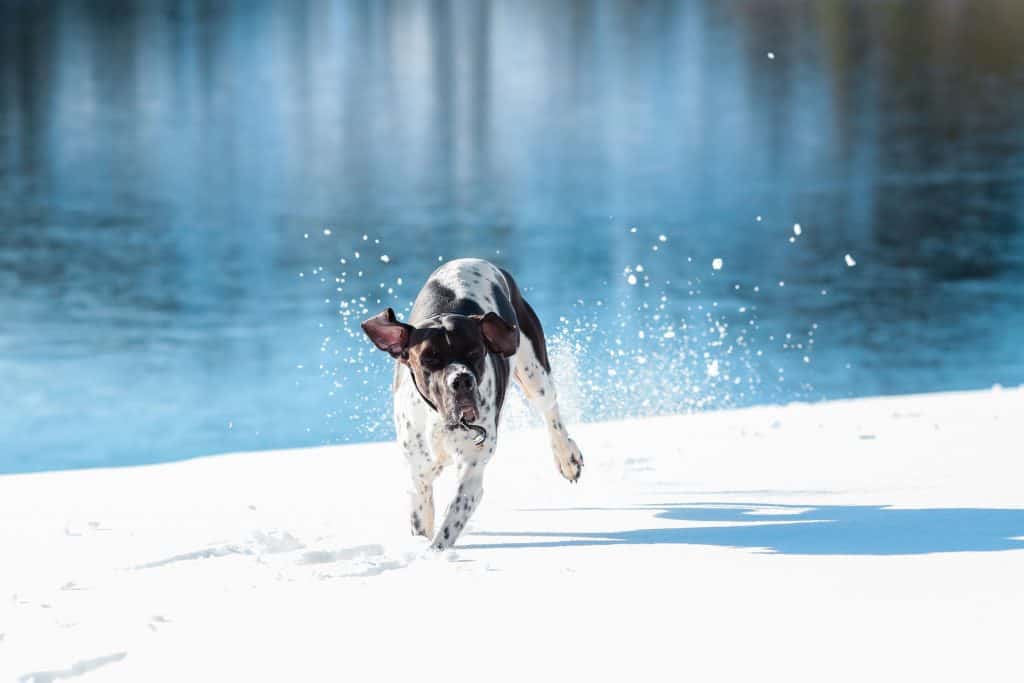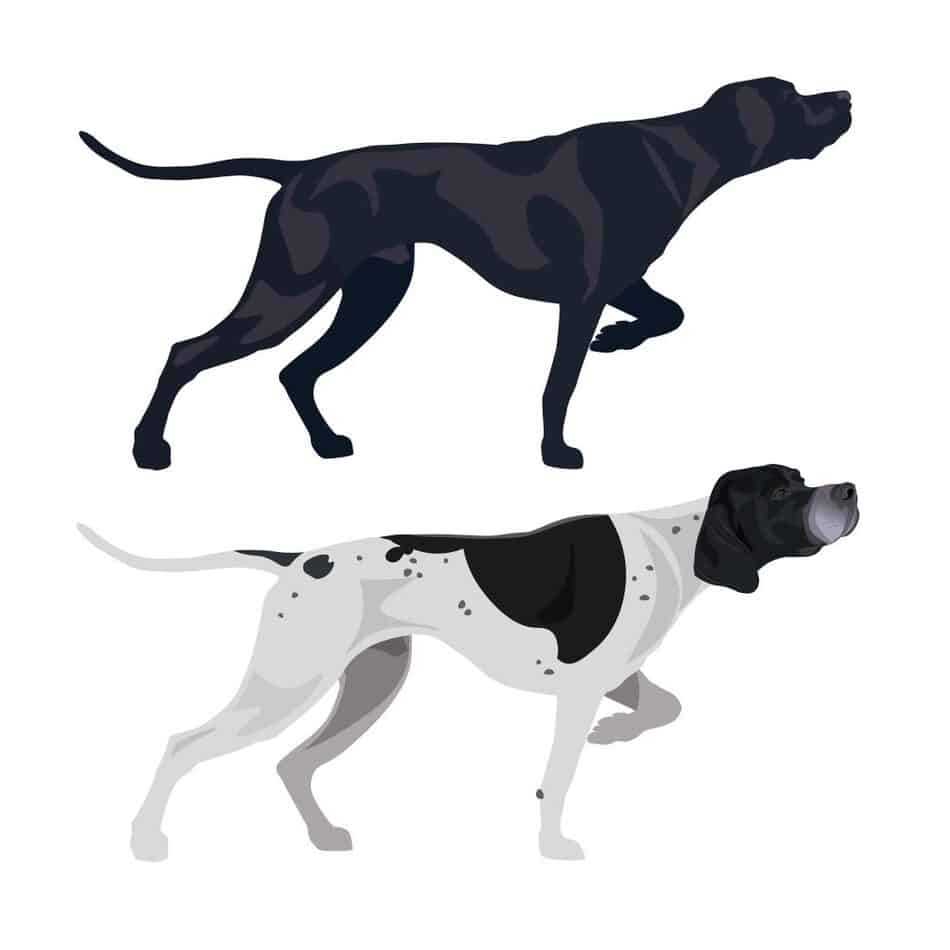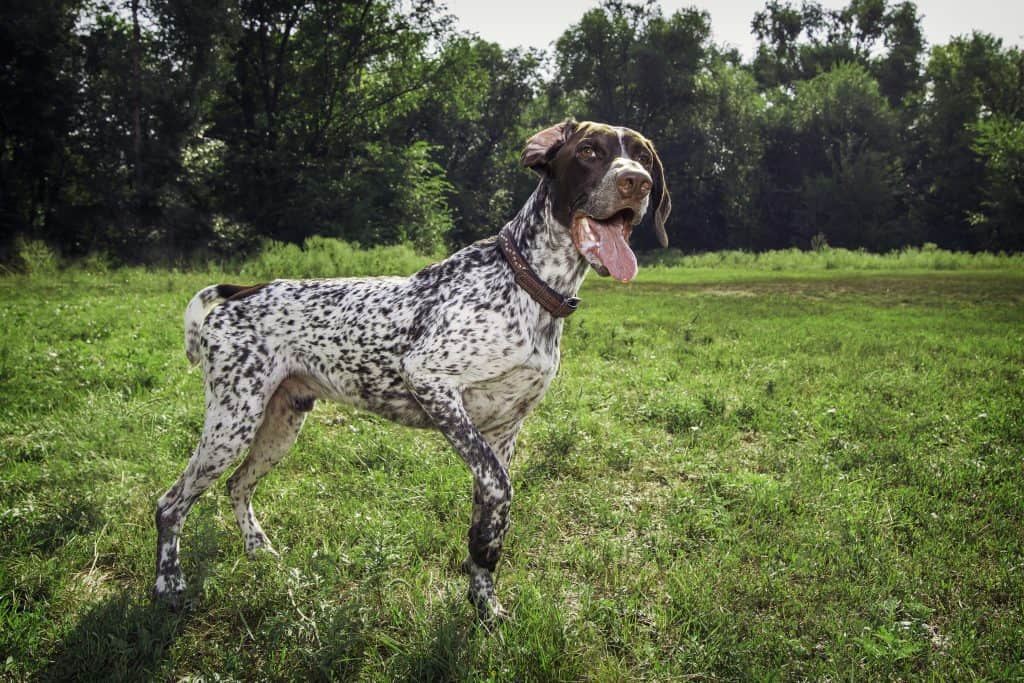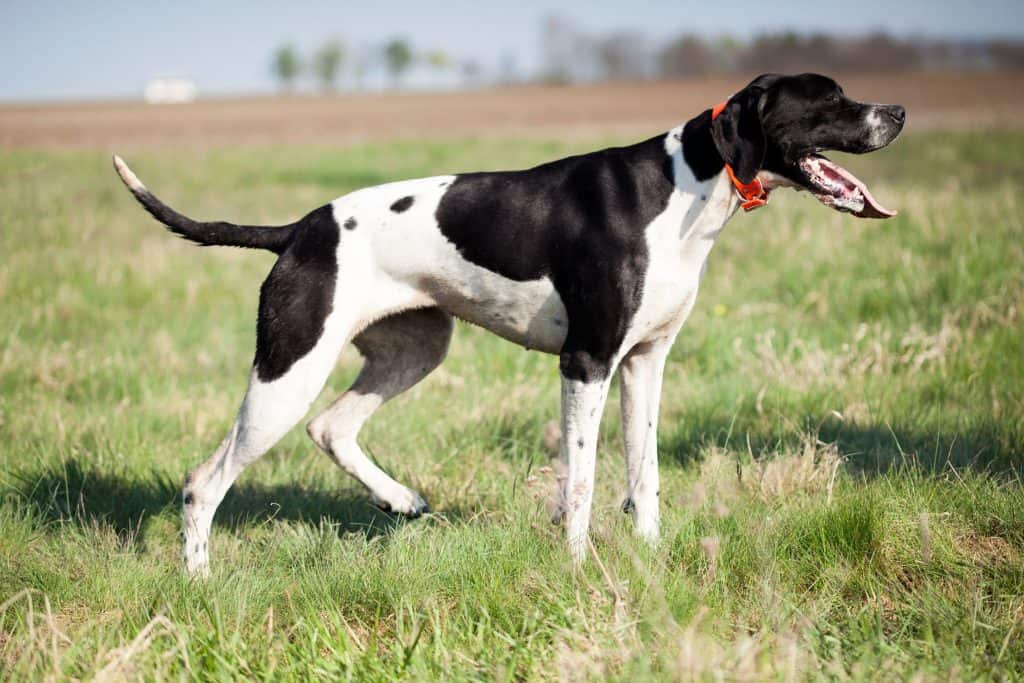Can Pointers Run Long Distances?

A pointer’s ability to run long distances is an interesting matter when thinking about their hunting history. They can hunt all day, but does that mean that they can make it very far if they just ran for it?
Pointers are known for running long distances; they can run 10 miles or more each day. Pointers have phenomenal endurance as well as the speed that comes from being bred for hunting. Their bodies are muscular and toned to make running easy.
Pointers can run long distances, but that doesn’t mean anything unless those distances are important in some way. There’s so much more to their ability to run far than just being able to make it all day on a hunting field. As a pet, this ability can pair greatly with certain lifestyles.
Running with Pointers
Pointers were bred with endurance in mind. Hunters needed them to be able to stay out in the field all day finding and pointing prey. Over the many centuries of breeding, pointers have come to be very athletic dogs with great speed and endurance.
Pointers can certainly run long distances. They can run more than 10 miles a day effortlessly. This makes them very good dogs for active owners. Some owners claim that their pointers can easily run a mile in under 7 minutes.
Some tell stories of their pointers running up to 40 miles a day! You don’t want to ever overextend your pointer, but they are very capable of running long distances due to their abundance of stamina, energy, and endurance.
Pointers’ High Energy
Their breeding has made their bodies naturally muscular and toned to allow speed and agility. They have incredible abilities to run for long periods of time-based off of their body structure alone.
Having a dog that can run long distances is not all blue skies and sunshine. Pointers require a lot of exercise every day to burn off their large stores of energy. They need a lot of outlets to prevent energy from building up and becoming destructive in your home or yard. This destruction can come in the form of chewing, digging, and barking.
Pointers are fantastic companions when they’re properly cared for. They are best suited for homes with owners that are very active and can spend the time needed to keep their dog moving and healthy.
Pointers are definitely dogs that need a lot of exercise. Their energy levels are significantly higher than other dog breeds. They make for very good running companions. They are also good at running alongside bike riders if that is more your speed.
Running and Cycling Companions
If you are someone who likes to run 5k’s and other long races, a pointer can be a great training buddy because of their endurance.
Running alongside you or a bike isn’t usually something that will just come naturally to your pointer; you’ll need to train them on the proper way to run with a lead and make sure that they’re not spending the entire time pulling you or wandering left and right in search of new things.
Pointers need a lot of training throughout their lives starting at a very early age. This general obedience training will really help your dog transition into new activities such as running with you or alongside a bike.
Cyclists may find it a tad more difficult to get your dog to run alongside the bike at first. He/she may be scared of the sounds it makes or the size of it. It can be nerve-wracking for him/her, and he/she may fear it hurting him/her.
Consistency, kind words, and practice are all you need to get your pointer used to the idea of running with a bike.
Hard pavements can be hard on your dog’s joints, so try to mix up the terrain a little as you go out. Try finding a walking trail or grassy area to do your running in. This can help protect your dog’s orthopedic health.
German Shorthaired Pointers are usually the pointers that are singled out as being the most athletic and obedient of the Pointer breeds.
They are known for their ability to run long distances at a steady pace. This skill does not diminish their need for speed, though. They are very agile creatures.
Most of the facts in this article are based around German Shorthaired Pointer statistics, but the information is also true for English Pointers and other pointer breeds.
Hunting Background Led to High Endurance

A pointer’s ability to run long distances can be traced back to their lineage.
The physical act of hunting, for a pointer, involves a lot of running back and forth over a big stretch of land searching and tracking a scent for hours. The terrain is not always perfect and this helps to demonstrate their complete athletic ability.
To complete these tasks, it requires a dog with enough stamina to last throughout the day. Hunters needed a dog who was fast and agile. The pointer’s muscled body and lean frame help to make them stealthier than other breeds.
They needed to be able to sneak up on prey to avoid startling it before the hunter can show up. These bodies allow them speed and endurance over long distances and time periods.
If you take the distance that a pointer runs around a hunting field, back and forth, and stretch it out into a straight line then you would clearly see that pointers have the capability of running long distance.
Athletic attributes are what make the pointer a phenomenal running and hunting partner, but those qualities come with a price. Pointers can become easily restless and bored if they’re not given the proper exercise.
Be Careful of Wanderlust and Distractibility in Pointers
Pointers have so much energy, stamina, and a tendency to chase anything that captures their attention. A big problem that owners face is letting their pointer out and he/she taking off because he/she saw a cat or squirrel that he/she wants to chase.
They don’t tire easily and your pointer could be out of sight before you even really know what’s going on.
Their curiosity and natural prey-drive can sometimes take over. Sometimes a pointer can chase something on a whim and not realize how far he/she has run. The easy distance he/she ran chasing something interesting can cause him/her confusion about which way is home.
A lot of pointers end up at the animal shelter for that reason. They wander too far and can’t find their way home. It’s important to keep your pointer on a leash whenever you are in the confines of an urban area.
Their wanderlust can get the best of them due to a natural instinct to chase prey. They are easily distracted, and it’s not always effective to call them back once their mind focuses in on what they want.
It’s better safe than sorry with pointers whose endurance could take them miles from home in a relatively short amount of time.
Health Problems Associated with Running Long Distances
Pointers do experience a few health problems that are characteristic to the breed. These problems can include hip dysplasia, eye problems, and epilepsy. Owners can do many things to avoid early onsets of these diseases and problems.
It’s not always the most dramatic diseases that your pointer could develop that you should be worrying about day to day. There are many problems that can occur in dogs from improper care. A lot of these things are simple things that a lot of us don’t think about as being a problem.
Running is a very good form of exercise for humans and dogs; however, if they’re not properly cared for before, during, and after the experience then they can have some problems.

One of the main things to keep in mind when running with a pointer is that they should not be running with you for exercise until at least 18 months old. As pointers develop, their joints, bones, and muscles are still getting stronger and growing.
Running on hard surfaces and trying to keep pace with someone running or riding a bike can cause some permanent joint damage that can affect them immediately or later in life.
Waiting until they’re at least 18 months old, for medium-sized dogs, can help ensure that they are protected from getting hurt while you’re running.
Another thing that isn’t widespread knowledge is the importance of nail care in dogs. You will want to make sure your dogs’ nails are regularly trimmed to prevent them from splitting painfully.
Dogs will also compensate for this pain by putting their weight on other parts of their foot while they run to prevent leaning on the nails. This can cause other problems for their paws.
Trimming a dog’s nails is sometimes a daunting task for owners because dogs don’t really like to have their feet grabbed and messed with. Understandably, they don’t react well with being held down.
You will want to expose your pointer to this regime early in its life. If you have a pointer puppy, you’ll want to handle them as much as possible and get them used to getting their nails clipped through consistency.
Puppies shouldn’t be running with you while you exercise to protect his/her joints, so you don’t have to worry about trimming his/her nails for that reason — you only have to worry about he/she getting used to the task and keeping the nails healthy at that age.
If you have an older dog, it’s never too late to start getting them used to the task. It’ll be frustrating at first, and you may need another person to help you.
Be gentle and make sure your dog knows when it’s doing a good job. Eventually, they will understand that they’re not going to get out of it by wiggling and whining and they’ll sit through the process.
Having your dog’s nails trimmed and neat will allow him/her to run great distances with you for long periods of time.
Keeping your dog safe and healthy while running with him/her will help both of you have a happy and positive experience together.
Another thing that can help keep your pooch safe when running is checking their paws and ears regularly. Aside from the nails, dogs can step on things that cut their paws or get lodged in them. You want to regularly check that they’re clean and healthy.
Running is fantastic exercise but it takes a little prep and post-workout checkups. The more time you give to your dog’s care, the better a running companion they will turn out to be.
Increasing the Distance Your Pointer Can Run
Pointers are superb athletes; they can run for miles on end at a consistent speed.
I don’t mean for this to sound too much like a fictional Willy Wonka land where he has ice cream that never melts even when sitting in the sun all day. Pointers will definitely tire after running for a while.
The distinction comes when comparing their endurance to other breeds of dog. They are definitely high up on the list of dogs that can run for hours and be the kind of tired all pointer parents want at the end of the day.
A healthy and tired pointer is a good pointer for the house. Owners find that their exuberance unabated in healthy ways can be too taxing for nighttime inside the house.
Pointers prefer to be with his/her family and will be a much happier dog if they’re able to run and expel the energy that sometimes gets them into trouble.
Their recommended daily exercise is “vigorous exercise” for at least 2 hours every day. They can certainly run for longer and farther if they wanted to.

Whenever you go running, it’s important to keep in mind the things that will keep your dog safe. Things that you’ll want to do include:
- start small
- listen to your dog
- water is key!
- use a harness and a short lead
There’s more that goes into running with your pointer than meets the eye. But if you do all you can to prepare, you’ll have a much better experience when you go out.
Start Small
Starting small is important to get your dog used to what you’re doing. You don’t want to go from throwing a ball at the park to running 10 miles in one day.
If you want your pointer to become your premier running companion, you’ll want to start with a good one or two-mile run at a steady pace. Slowly increase the distance over time.
Your pointer will be excited to be with you running and enjoying life. These beautiful athletes thrive when they’re on the move. When you combine that with their love of being with their family, you get a pointer bursting with happiness every day.
Pay Attention
Another thing that’s very important when running with your dog is listening to them. This doesn’t mean that you should just pay attention when they bark — you’ll want to take into account how they’re acting and sounding throughout the run.
Most dogs will run with you for hours without trying to stop or lay down. The pointer certainly will run until he/she physically drops. You want to keep him/her safe and healthy, so make sure to pay attention to when he/she is lagging behind or slowing down.
This could indicate that he/she needs to stop. You don’t want to force your dog to keep going when he/she is showing signs of weariness. Slow down and walk home for the day if your pointer starts to pull on the lead and lag far behind you.
You’ll also want to listen for ragged breathing or heavy panting; This could be a sign that he/she needs to be done for the day or that water is needed.
This leads me to another important point: give your dog plenty of water!
Water is Key
When we go on runs, we always have a water bottle that we drink from frequently. Dogs are no different. They need to stay hydrated throughout the exercise.
Remember to bring along water for them and give them breaks to drink every so often. If you need a drink, chances are they need one too.
Harness and Lead
Finally, you’ll want to invest in a good harness for your pointer. A combination of the breed’s wanderlust and a general need for more support comes together to make this a key issue.
A lead attached to a collar can pull on your pointer’s neck and hurt his/her back over time. A harness is much safer in the sense that it spreads out the pull of the leash over a broader area.
The harness will keep your dog safe and allow you to have more control if he/she gets distracted by a runaway squirrel. You’ll also want a simple 6-foot lead instead of a long lead or retractable leash.
A longer lead or retractable leash allows your dog too much freedom and gives you little control over him/her, his/her movements, and general distance from you.
How you exercise with your pointer is completely between you and your dog. There are various things you could do to that give the same benefits as running. Finding what makes you happy is all you can do.
Running is very familiar and natural to pointers. They were made to run long distances and for a long time. Having them in a household that doesn’t hunt limits their ability to expel energy through a full day of tracking.
A light walk every night will simply not suffice when it comes to these dogs. Regular running can be one of the best ways to keep your pointer healthy and it’s something that you can do too to keep yourself in good shape. Seems like a win-win for the dog community to me.
